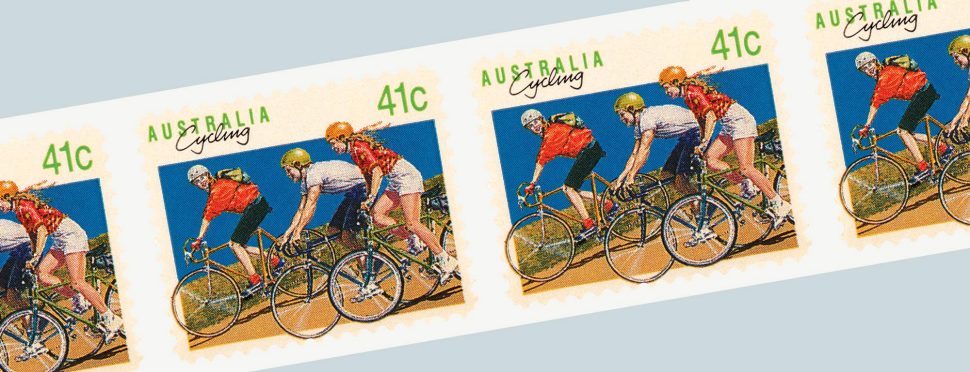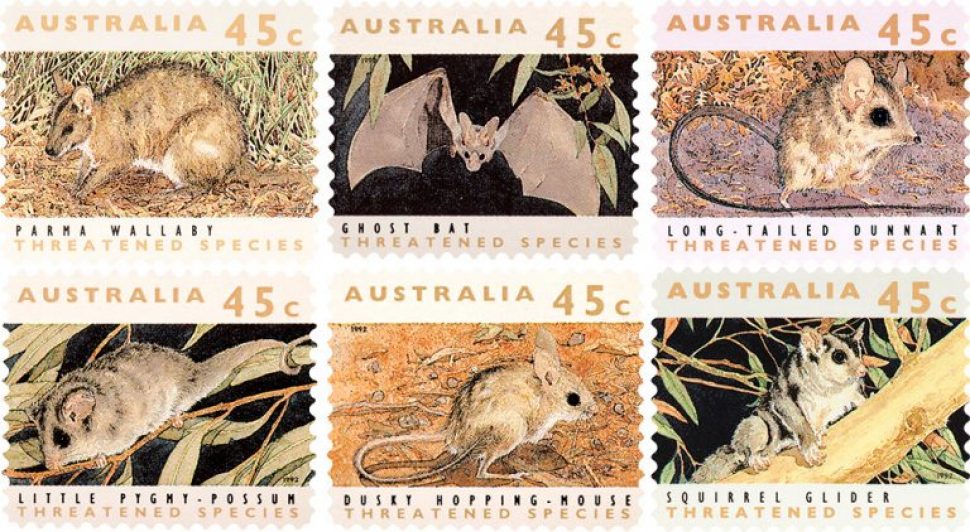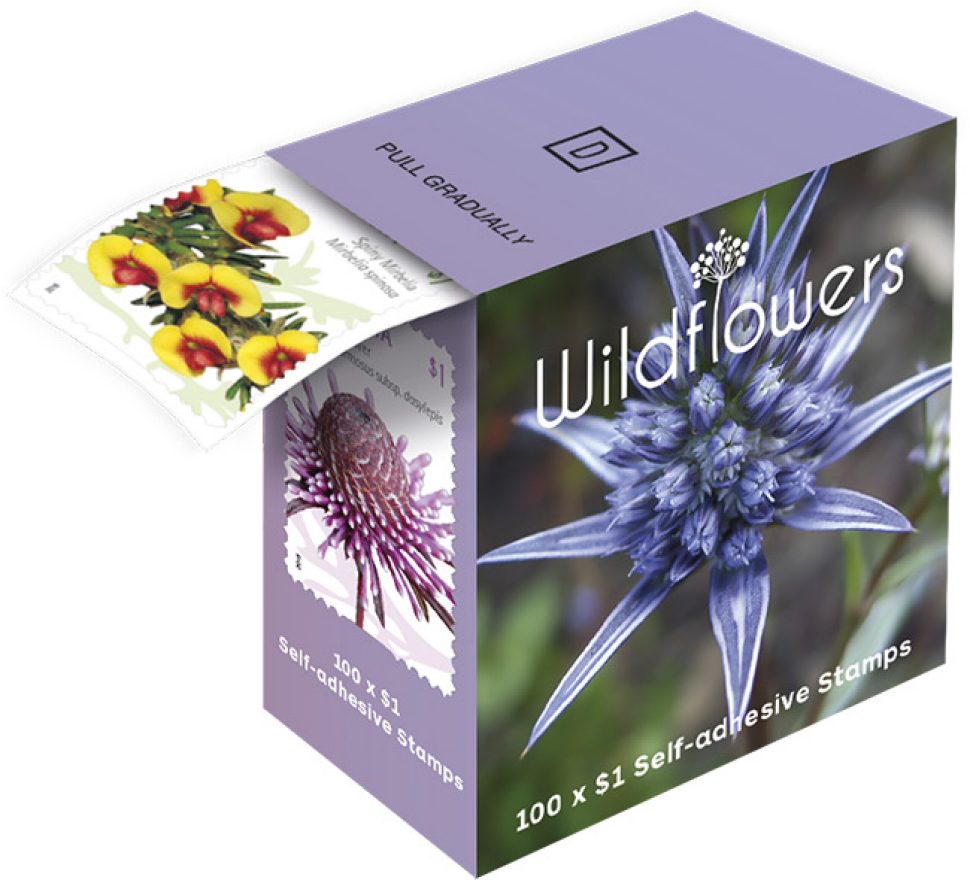In the 1990s, Australia Post created a world first: mass produced self-adhesive stamps for general and widespread use. This led to increased convenience for postal users and revolutionary changes globally to postage stamp production.
The “peel and stick” experiment
In the late 1980s, Australia Post planned to introduce self-adhesive stamps for small business, as a way to ‘test the waters’. Originally called “peel and stick stamps”, they were meant to be a convenient alternative for small businesses that had only a few hundred mail items per month (which meant they probably didn’t have a franking machine). This ‘experiment’ paid dividends straight away, to the point that Australia Post couldn’t initially keep up with demand.
The first self-adhesive stamp was issued on 16 May 1990. The stamp was based on the gummed 41c Cycling stamp in the Sports definitive series. This was the current base rate definitive in 1990, so the new self-adhesive looked very similar to its gummed counterpart.
Two key decisions were made in relation to the appearance of Australian self-adhesive stamps: they should use the same design as their gummed equivalent (to appeal to collectors of gummed stamps) and they should feature die-cut simulated perforations (again, to look as similar as possible to gummed stamps). The simulated perforations were also important from a security standpoint, because they are a difficult element to forge.
While it is claimed that self-adhesive stamps existed prior to the 1990s (as early as the 1960s in fact), these attempts did not involve self-adhesive stamps on a mass scale, they did not lead to general usage of self-adhesive stamps on a global scale and they did not have perforated edges, which is really what sets a stamp apart from a mere ‘sticker’.
For example, Sierra Leone issued non-perforated, self-adhesive stamps in 1964, which it did so for the next seven years. Tonga produced self-adhesive stamps, between 1969 and 1985. Both countries found cost prohibited them from continuing. Norfolk Island also issued occasional self-adhesive stamps from 1974 to 1978. Other instances of ad-hoc self-adhesive stamp products include the United States, Japan and Canada.
The evolution self-adhesive stamps in Australia
Self-adhesive stamps were initially issued in rolls of 100 for the convenience of business users. However, the general public made it known that they wanted self-adhesive stamps too. This led to the issue of booklets of ten in January 1992, coinciding with a stamp rate rise, followed by a sheetlet of five.
Within a year of being introduced, self-adhesive stamps had won such a high degree of acceptance that 40 per cent of base rate stamps on business mail were self-adhesive. After three years of self-adhesive stamps, they accounted for 70 per cent of all base rate stamp sales and around 50 per cent of all stamps of all denominations. Today, 90 per cent of all stamps produced for general usage by Australia Post are self-adhesive.
Australia Post’s market research showed that the public wanted to see more than just one base rate self-adhesive stamp. This led to the release of six designs as part of the 1992 Threatened Species issue.
The next development was to supplement definitive issues with a self-adhesive version of the regular issues of commemorative and special stamps. The practice, which continues today, began with the 1993 Trains stamps. And since 1995, the Australia Post Christmas stamps have been issued in self-adhesive booklets of 20 stamps.
Currently, each self-adhesive issue includes rolls or booklets, or a combination of both.
Printing self-adhesive stamps in Australia
When Australia Post introduced self-adhesive stamps in 1990, their private sector printing supplier, Leigh-Mardon was not equipped to print this new kind of stamp, so the task went to Pemara Labels Pty Ltd of Notting Hill, Melbourne. Soon after, Printset-Cambec Pty Ltd of Knoxfield, Melbourne also commenced print production of self-adhesive stamps. After various name changes (the last being to SNP Print), the latter company went into administration in 2008.
Australia Post now has four printers currently contracted to produce gummed and self-adhesive stamps: Pemara Labels, McKellar Renown Press, EgoTrade and RA Printing. Pemara is the only printer that supplies rolls of 100 and 200 self-adhesive stamps. McKellar Renown, EgoTrade and RA Printing all supply gummed stamps and self-adhesive booklet products.
Self-adhesive stamps at Pemara are printed using a flexographic print process (it was previously letterpress printing, followed by offset photolithography). The other three printing firms use offset lithography via sheet-fed printers, which are also used to apply the phosphor.
Phosphor is the luminescent substance incorporated in stamps to activate the automatic sorting machines that process the mail in the mail centre. Unlike gummed stamps, which are printed onto paper already containing phosphor, the phosphor layer is applied separately onto self-adhesive stamps. It is not applied to the full stamp surface either, as this would interfere with the absorption of postmarking ink. It usually applied to a single area of the stamp design (generally in a light area), making it easier to read by mail sorting machines. Ultra violet lamps are used during the production process, so that staff can check whether they have applied the varnish correctly.
The self-adhesive paper used to print the stamps is made specifically for Australia Post, to meet the particular requirements for stamp printing. The paper comprises a top layer positioned over a backing paper, from which the stamp is peeled away. The two layers are held together by an adhesive that remains attached to the stamp after separation.
Once the sheets of stamps have been printed and phosphor varnishing has been applied, the next step involves die-cutting the simulated perforations. Die-cutting, also known as ‘kiss-cutting’, is a precision method where the base paper must be cut through cleanly, though not past the backing paper.
Finishing of self-adhesive stamps at Sprintpak
The finishing work (assembling the printed stamp sheets into rolls and booklets as well as checking and despatching functions) is handled by Australia Post Sprintpak, a wholly-owned subsidiary of Australia Post and part of the Philatelic team.
The self-adhesive stamp printers deliver their product in an unfinished state to Sprintpak for the final stages of roll and booklet production. The printers supply jumbo reels of roll stamps, which are about the size of a small car wheel. Booklet and sheetlet stamps are delivered as untrimmed, flat sheets.
The jumbo reels are mounted onto a machine at Sprintpak, which automatically counts the stamps as they are spooled passed sensors that check for missing stamps. Any missing stamps are simply replaced with new ones. At the same time as the stamps are being spooled, the machine’s slitting wheels slice the jumbo rolls down into single stamp widths. The whole process stops when the rolls contain either 100 or 200 stamps, and a machinist slices off the finished rolls. The remaining steps involve inserting stamp rolls into their dispenser boxes, sealing the boxes to make them tamper-proof and packing them for distribution to Post Offices.
Upon receipt of printed sheets of self-adhesive booklets, Sprintpak count and bind 20 individual stamp booklets into a “chequebook” style booklet. They are then guillotined down to finished booklet size and packed ready for despatch. Production of self-adhesive stamp sheetlets follows a similar process. Individual booklets are also folded to finished booklet size and packaged in a “hang-sell” format, for purchase in Post Offices.
View the production process for the Wildflower stamps in the amazing wildflowers of the west post.
Australian technology goes global
Other countries soon began to take advantage of Australia’s revolutionary self-adhesive stamp technology. Australia Post has produced self-adhesive stamps for many countries, including Ireland, Belgium, Portugal, Switzerland, New Zealand, South Africa, Hong Kong, Singapore, Indonesia and Thailand.
Almost all of the countries that Australia Post has produced self-adhesive stamps for in the past have since developed their own printing capability, either locally or within their region. Australia Post Sprintpak still remains active in export markets, submitting tenders for both gummed and self-adhesive products, as opportunities arise.
The world-wide adoption of the innovative techniques developed in Australia is a testament to the ingenuity of all those involved in the “peel and stick” experiment.
This article was produced at the time of publication and will not be updated.







